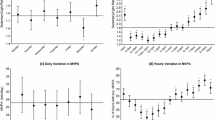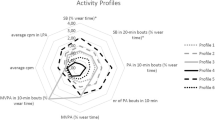Abstract
Purpose
Research conducted on the general population indicates self-reported measures of physical activity and sedentary behaviour are inaccurate when compared with objective measures; however, it is not clear if this also applies to cancer survivors. In this study, we compared accelerometer-based and self-reported measures of moderate- to vigorous-intensity physical activity (MVPA) and sedentary time among colon cancer survivors.
Methods
A total of 176 colon cancer survivors, recruited from the Western Australia and Alberta cancer registries, wore an Actigraph GT3X+ accelerometer for 7 days and completed self-reported questions about recent MVPA (Godin Leisure-Time Exercise Questionnaire) and usual sedentary time (Marshall Domain-Specific Sitting Questionnaire). Accelerometer data were processed using 60-s epochs and summarized using Freedson’s cut points. Spearman’s rho and intraclass correlation coefficients (ICCs) were used to assess correlation and agreement for daily MVPA and sedentary time estimates from the two methods.
Results
Total mean minutes per day spent in MVPA was 12 min based on accelerometer data and 26 min based on self-reported data (P Difference < 0.01). Correlation between the methods was fair (rho = 0.51); however, agreement was poor (ICC = 0.33). Mean daily time spent sedentary was similar in both methods (∼8.5 h); however, both correlation and agreement were poor (rho = 0.19, ICC = 0.16).
Conclusions
We found fair correlation but poor agreement between the self-reported and accelerometer-based assessments of MVPA used in this study. For sedentary time, both correlation and agreement between the two methods were poor. Studies of colon cancer survivors using these self-report measures are likely to have a considerable amount of exposure misclassification.
Similar content being viewed by others
References
Rock CL, Doyle C, Demark-Wahnefried W et al (2012) Nutrition and physical activity guidelines for cancer survivors. CA Cancer J Clin 62:242–274
Schmitz KH, Courneya KS, Matthews C et al (2010) American College Of Sports Medicine roundtable on exercise guidelines for cancer survivors. Med Sci Sports Exerc 42:1409–1426
Sedentary Behaviour Research Network (2012) Letter to the editor: standardized use of the terms “sedentary” and “sedentary behaviours”. Appl Physiol Nutr Metab 37:540–542
Lynch BM, Dunstan DW, Vallance JK, Owen N (2013) Don’t take cancer sitting down. Cancer 119:1928–1935
Prince S, Adamo K, Hamel M et al (2008) A comparison of direct versus self-report measures for assessing physical activity in adults: a systematic review. Int J Behav Nutr Phys Act 5:56
Dyrstad SM, Hansen BH, Holme IM, Anderssen SA (2014) Comparison of self-reported versus accelerometer-measured physical activity. Med Sci Sports Exerc 46:99–106
Healy GN, Clark BK, Winkler EAH et al (2011) Measurement of adults’ sedentary time in population-based studies. Am J Prev Med 41:216–227
Helmerhorst HJ, Brage S, Warren J, Besson H, Ekelund U (2012) A systematic review of reliability and objective criterion-related validity of physical activity questionnaires. Int J Behav Nutr Phys Act 9:103
van Poppel MNM, Chinapaw MJM, Mokkink LB, van Mechelen W, Terwee CB (2010) Physical activity questionnaires for adults: a systematic review of measurement properties. Sports Med 40:565–600
Mao JJ, Armstrong K, Bowman MA et al (2007) Symptom burden among cancer survivors: impact of age and comorbidity. J Am Board Family Med 20:434–443
Jovanovic JL, Hughes DC, Baum GP et al (2011) Accelerometry and self-report in sedentary populations. Am J Health Behav 35:71–80
Su C-C, Lee K-D, Yeh C-H, Kao C-C, Lin C-C (2014) Measurement of physical activity in cancer survivors: a validity study. J Cancer Surviv 8:205–212
Johnson-Kozlow M, Sallis J, Gilpin E, Rock C, Pierce J (2006) Comparative validation of the IPAQ and the 7-day PAR among women diagnosed with breast cancer. Int J Behav Nutr Phys Act 3:7
Johnson-Kozlow M, Rock CL, Gilpin EA, Hollenbach KA, Pierce JP (2007) Validation of the WHI brief physical activity questionnaire among women diagnosed with breast cancer. Am J Health Behav 31:193–202
Liu R, Buffart L, Kersten MJ et al (2011) Psychometric properties of two physical activity questionnaires, the AQUAA and the PASE, in cancer patients. BMC Med Res Methodol 11:30
Pinto BM, Papandonatos GD, Goldstein MG, Marcus BH, Farrell N (2013) Home-based physical activity intervention for colorectal cancer survivors. Psychooncology 22:54–64
Vallance JK, Boyle T, Courneya KS, Lynch BM (2014) Associations of objectively-assessed physical activity and sedentary time with health-related quality of life among colon cancer survivors. Cancer 120:2919–2926
Godin G, Shephard RJ (1985) A simple method to assess exercise behavior in the community. Can J Appl Sport Sci 10:141–146
IPAQ Research Committee (2005) Guidelines for data processing and analysis of the International Physical Activity Questionnaire (IPAQ)-Short and Long Forms. http://www.ipaq.ki.se/scoring.pdf. Accessed 14 May 2014
Marshall AL, Miller YD, Burton NW, Brown WJ (2010) Measuring total and domain-specific sitting: a study of reliability and validity. Med Sci Sports Exerc 42:1094–1102
Gardiner PA, Healy GN, Eakin EG et al (2011) Associations between television viewing time and overall sitting time with the metabolic syndrome in older men and women: The Australian Diabetes Obesity and Lifestyle Study. J Am Geriatr Soc 59:788–796
Matthews CE, Chen KY, Freedson PS et al (2008) Amount of time spent in sedentary behaviors in the United States, 2003–2004. Am J Epidemiol 167:875–881
Freedson PS, Melanson E, Sirard J (1998) Calibration of the Computer Science and Applications, Inc. accelerometer. Med Sci Sports Exerc 30:777–781
Sasaki JE, John D, Freedson PS (2011) Validation and comparison of actigraph activity monitors. J Sci Med Sport 14:411–416
Terwee CB, Mokkink LB, van Poppel MNM et al (2010) Qualitative attributes and measurement properties of physical activity questionnaires: a checklist. Sports Med 40:525–537
Broderick JM, Hussey J, Kennedy MJ, O’Donnell DM (2014) Testing the ‘teachable moment’ premise: does physical activity increase in the early survivorship phase? Support Care Cancer 22:989–997
Broderick JM, Guinan E, Kennedy MJ et al (2013) Feasibility and efficacy of a supervised exercise intervention in de-conditioned cancer survivors during the early survivorship phase: the PEACH trial. J Cancer Surviv 7:551–562
Broderick JM, Ryan J, O’Donnell DM, Hussey J (2014) A guide to assessing physical activity using accelerometry in cancer patients. Support Care Cancer 22:1121–1130
Bull FC, Maslin TS, Armstrong T (2009) Global Physical Activity Questionnaire (GPAQ): nine country reliability and validity study. J Phys Act Health 6:790–804
Acknowledgments
Terry Boyle and Brigid Lynch are supported by Early Career Fellowships from the Australian National Health and Medical Research Council (#1072266 & #586727 respectively). Terry Boyle is also supported by a Fellowship from the Canadian Institutes of Health Research (#300068), a Postdoctoral Fellowship from the Michael Smith Foundation for Health Research (#5553), and an Honorary Killam Postdoctoral Research Fellowship from The University of British Columbia. Brigid Lynch is also supported by the Victorian Government’s Operational Infrastructure Support Program. Jeff Vallance and Kerry Courneya are supported by the Canada Research Chairs program. Jeff Vallance is also supported by a Population Health Investigator Award from Alberta Innovates—Health Solutions. We would like to acknowledge Parneet Sethi and Dr. Elisabeth Winkler for their assistance in data processing and analyses.
Conflict of interest
None of the authors have any conflicts of interest to declare.
Author information
Authors and Affiliations
Corresponding author
Rights and permissions
About this article
Cite this article
Boyle, T., Lynch, B.M., Courneya, K.S. et al. Agreement between accelerometer-assessed and self-reported physical activity and sedentary time in colon cancer survivors. Support Care Cancer 23, 1121–1126 (2015). https://doi.org/10.1007/s00520-014-2453-3
Received:
Accepted:
Published:
Issue Date:
DOI: https://doi.org/10.1007/s00520-014-2453-3




